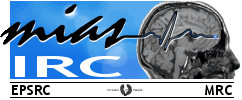 |
There are currently, 8 guest(s) and 0 member(s) that are online.
You are Anonymous user. You can register for free by clicking here |
|
Select Interface Language:
|
|  |
|
Registration Assessment Without Ground Truth Proven Most Sensitive
|
|
 N recent weeks we have worked towards a batch of publication on our recent work. That work is primarily focused on assessement of registration with and without ground truth. Below is a short summary of the work. More details are yet to be published in this site soon.
N recent weeks we have worked towards a batch of publication on our recent work. That work is primarily focused on assessement of registration with and without ground truth. Below is a short summary of the work. More details are yet to be published in this site soon.
A diverse collection or methods exist for the problem of non-rigid registration, whereby a set of images is to be aligned. We perceive a deficiency, however, in the ways such registrations are validated or even evaluated. We devised two methods for evaluating non-rigid registration. One of the methods requires ground-truth solutions to be provided a priori, yet the other does not. We have collected results, which confirm that both methods are valid and proceeded to calculating their sensitivities. We find that the method which requires ground-truth solutions is not as sensitive as the method which need not have anything but the raw images and the corresponding deformation fields.
It is worth mentioning that, for the time being, segmentation is not considered. We are aware that it has great potential for being incorporated into the framework and, moreover, we have observed results that served as 'proof of concept' for this contention. We are yet to do some similar work on sets of faces if time permits.
|
|
Evaluation of Appearance Models
|
|
 There is another project that parallels with MARS. Evaluation of models, which involved a long series of experiments, have shown considerable promise. An algorithm was devised for assessing the quality of non-rigid registration and for evaluating appearance models with application to face and brain data.
There is another project that parallels with MARS. Evaluation of models, which involved a long series of experiments, have shown considerable promise. An algorithm was devised for assessing the quality of non-rigid registration and for evaluating appearance models with application to face and brain data.
|
 We are approaching a framework whereby labels (segmentation) can be bound to a single image and then automatically be used to infer the labelling in other images. This has the potential of saving a great deal of manual work which traditionally goes into segmenting images. Furthermore, since data from a group of images is used, there ought to be added robustness to noise. This helps in surpassring stand-alone segmentation, which is typically handled by investigating a single image at a time.
We are approaching a framework whereby labels (segmentation) can be bound to a single image and then automatically be used to infer the labelling in other images. This has the potential of saving a great deal of manual work which traditionally goes into segmenting images. Furthermore, since data from a group of images is used, there ought to be added robustness to noise. This helps in surpassring stand-alone segmentation, which is typically handled by investigating a single image at a time.
The framework, which relies on non-rigid registration, is illustrated schematically below.
|
|
Segmentation Propagation from Model
|
|
 The next advancement to demonstrate is that segmentation of of one image can be propagated to an entire group of similar images.
The next advancement to demonstrate is that segmentation of of one image can be propagated to an entire group of similar images.
The mechanism which enables the propagation is model construction, which has the notion of correspondences. For each point that resides in a segment, a corresponding point can be found in another image. From this, an analogous segment in other images can be identified. If the correspondence is dense (i.e. incorporates all points in a continuous space), then entire labels can be propagated from one image to similar image in the entire group. Non-rigid registration provides that dense correspondence which is necessary.
An advantage of this approach, which is worth pointing out, is that use of a group of images for segmentation compensates for noise in the images. By using information possessed by the image group, robustness can be gained.
|
|
Mean of Squared Differences (MSD) Unstable at Registration
|
|
 There is one key problem that must be resolved somehow. Transformation in MARS is handled using clamped-plate splines (CPS) and an MSD-based objective function does not identify its minimum value when it is forced to lie in the correct solution.
There is one key problem that must be resolved somehow. Transformation in MARS is handled using clamped-plate splines (CPS) and an MSD-based objective function does not identify its minimum value when it is forced to lie in the correct solution.
The little, fine bits on the top of bumps are unwanted
artefacts that result in improved MSD evaluation.
|
|  |
|
There isn't content right now for this block.
|
Don't have an account yet? You can create one. As a registered user you have some advantages like theme manager, comments configuration and post comments with your name. |
|
There isn't a Biggest Story for Today, yet.
|
|
There isn't content right now for this block.
|
| 
|




